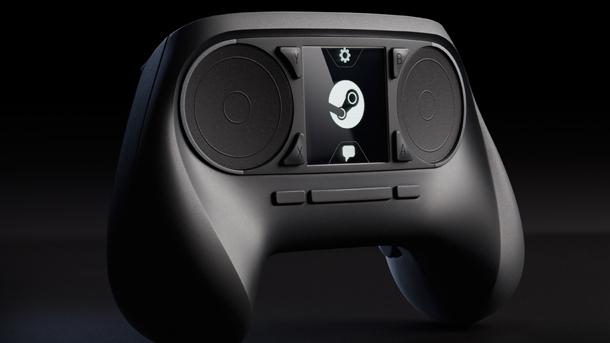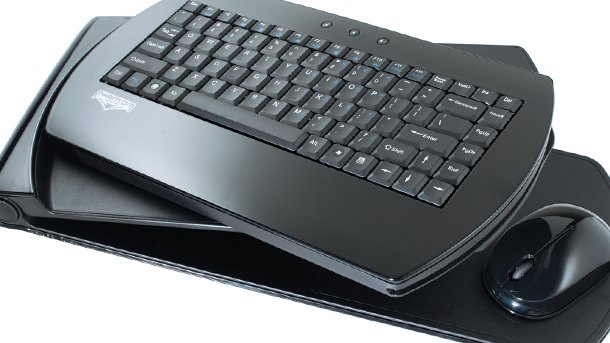Steam Controller isn't enough: why PC gamers need a couch-friendly keyboard and mouse

In 2013 Valve told us that it's making a controller , an operating system , and is sanctioning PC manufacturers to create Steam Machines . The three-pronged campaign to put Steam in your living room, deliberately revealed ahead of the launch of the Xbox One and PlayStation 4, was the biggest PC gaming news of the year. It's a move that establishes Valve as something that resembles a platform holder, something it's been hesitant to do despite being the PC's biggest online retailer.
We're glad that Valve is removing some of the obstacles to playing Civilization V on our couch. It gets us imagining PC gaming as a more social experience for friends, family members, and whatever other human beings you let into your house. That picture will come into focus at CES next week, when we expect a second wave of information from Valve on its initiative.
We'll also hopefully leave Vegas with a better understanding of how versatile the Steam Controller is, which we've been investigating . But even if Valve's controller exceeds our expectations and plays a very wide set of games comfortably, there's an serious need for a keyboard and mouse platform that can be used effortlessly on a couch. I'm challenging accessory makers like Razer and Logitech to make one.
Control issues
Just 290 of Steam's 2,459 games feature full controller support, and 502 feature partial support—a cumulative third of the library. Even if we give generous consideration to Valve's claim that the Steam Controller “[fools] older games into thinking they're being played with a keyboard and mouse,” I'm still going to need to edit command lines, to chat with my Steam friends, to Alt + Tab, and no amount of virtual keyboards, haptic feedback, and autocomplete will ameliorate that. In particular, I don't have high hopes for how well hotbar-heavy games like Dota 2, Starbound, Path of Exile, RTSes and MMORPGs will handle on the Steam Controller.

The peripheral, though, isn't actually the problem—it's the absence of a stable surface in the living room that rests above your legs. Our friends at Tested put it this way in an article from last July: “If you just put your mouse and keyboard on the coffee table and perch on the edge of your couch, you're gonna hurt your neck and back, craning your neck to see the TV.” Conventional mice and keyboards can work in the living room, but not without a desklike platform to rest them on.
Infinium Labs—yes, that Infinium Labs —now known as Phantom Entertainment, produced one of the only commercial solutions to this problem, the Phantom Lapboard: a $110, wireless, cantered keyboard and mouse combo. It's bad. “The bottom line is that this thing is bad,” our sister site Maximum PC said in its 2010 review . The keyboard only tilts at a single angle, the mouse only features two buttons and a scroll wheel, and there's no lip on the surface to contain it. “The second you take your hand off the mouse to type something, that sucker's clattering to the floor,” MaxPC wrote.
The Couchmaster is the weirder and even more expensive alternative, a hulking, 24”-wide, upholstered thigh prison that at least provides a stable, ergonomic surface. But it's a frown-inducing $180, and its cumbersome shape doesn't seem conducive to easy storage or use in any living room that doesn't feature a wide couch.
The biggest gaming news, reviews and hardware deals
Keep up to date with the most important stories and the best deals, as picked by the PC Gamer team.
Apart from Ikeaing something wooden and rigid together, the two options PC gamers have are pricey and strange. If anything, they show us two designs that any future lapboards should avoid, or at least iterate on aggressively. With Valve's initiative, third-party manufacturers should be scrambling to produce a lapboard that accommodates gaming mice and keyboards, if only because it's an item that will help them sell more mice and keyboards. Razer has a small history of experiments like the Artemis prototype and the Razer Hydra , but more practically, they already make left-handed keypads like the Orbweaver and Nostromo, devices that would be the perfect starting points for a compact lapboard. Logitech would be another good candidate; they make plenty of mainstream wireless peripherals, and on the gaming side they have an ambidextrous keypad we like, the G13 .
Valve should want such a peripheral to be available as an alternative to its controller. After all, a sturdy, inexpensive, versatile gaming lapboard would absolutely increase the adoption of living room PCs and SteamOS. Valve's goal isn't to sell controllers, it's to get you playing PC games on your couch, and we should all want that proposition to be as effortless as possible.
An innovative controller can't and won't replace the decades-long relationship PC gamers have with WASD because PC gamers don't like compromise—we expect high framerate, high resolution, low cost, and total freedom to modify our devices and games. And while we're grateful for a controller that's built with PC gamers and PC games in mind, it's essential that we get a compromise-free way of bringing the core implements of our hobby, the mouse and keyboard, into the living room.

Evan's a hardcore FPS enthusiast who joined PC Gamer in 2008. After an era spent publishing reviews, news, and cover features, he now oversees editorial operations for PC Gamer worldwide, including setting policy, training, and editing stories written by the wider team. His most-played FPSes are CS:GO, Team Fortress 2, Team Fortress Classic, Rainbow Six Siege, and Arma 2. His first multiplayer FPS was Quake 2, played on serial LAN in his uncle's basement, the ideal conditions for instilling a lifelong fondness for fragging. Evan also leads production of the PC Gaming Show, the annual E3 showcase event dedicated to PC gaming.

